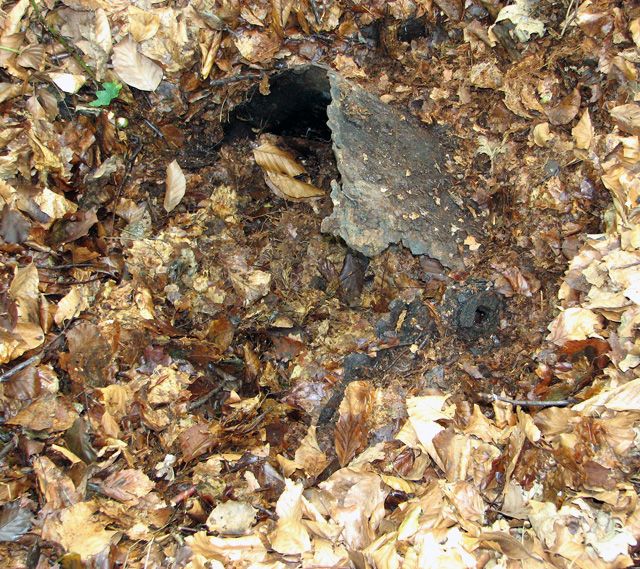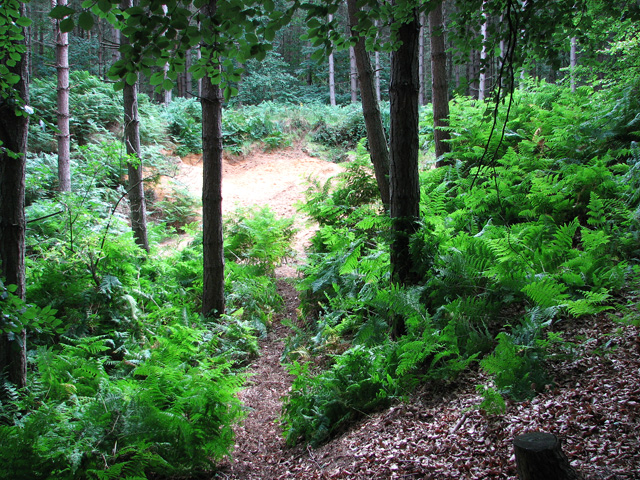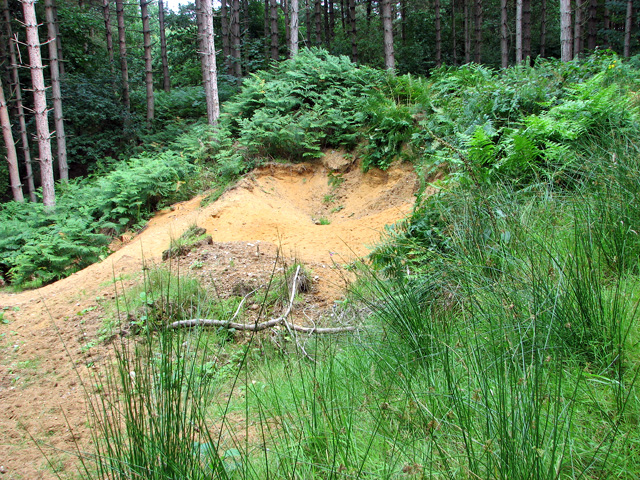Erpingham is 4 miles north of Aylsham.
| Name | Occupation | Posted from | Until |
|---|---|---|---|
| Sergeant Alexander Connell Scott | Farmer |
Unknown | 03 Dec 1944 |
| Private Raymond William Buller | Tractor driver |
Unknown | 03 Dec 1944 |
| Private Max Patrick Vernon Cremer | Motor mechanic |
Unknown | 03 Dec 1944 |
| Private Leonard Alfred Daniels | General farmer |
Unknown | 03 Dec 1944 |
| Private John Philip Everett | Farmer |
Unknown | 03 Dec 1944 |
| Private David MacKay | Head horseman |
Unknown | Unknown |
| Private George Henry Wolstenholme | Poultry farmer |
Unknown | 03 Dec 1944 |
The OB is near a disused track through Old John’s Wood, about 120 metres south from Top Hill Road. Old John’s Wood is a private woodland forming part of the Gunton Estate.
The OB was described to us as having had a flat roof, with the inside lined with corrugated sheets and supported by heavy timbers. It had Calor gas lighting, a medical kit and iron rations. The entrance was a drop-down shaft lined with corrugated sheets. The escape tunnel was about 10 metres long and had a trapdoor.
Following directions given to us by former Patrol member John Everett, we found a clearly defined rectangular depression at about 1.50 to 2 metres below the upper edge of a disused sandpit located within the woodland.
Scattered about at the site are numerous shards from ceramic field pipes. We found no trace of corrugated iron sheets or wooden posts. The evidence on the ground suggests that the flat roof of the structure has collapsed some time ago and that the remains are now lying at the bottom of the main chamber, covered with layers of sand. We were unable to determine if the structure was perhaps deliberately covered with sand/filled in, in order to block access.
Mr Everett mentioned an ammunition and explosives store nearby. He believes that it still contains a number of phosphorous bombs in bottles that were originally kept in a wooden crate. We failed to find the location which was described to us as a depression in the ground. We did, however, find a small round depression in the ground about 45 metres to the north-west of the OB site. The top of a 40-gallon drum is only just visible amongst the leaves gathered there. We removed some of the leaves in order to get a better view. The drum is much corroded. We preferred to not try and find out if this might have been the explosives store.
Erpingham Patrol
John Everett was not aware of any specific targets but Gunton Hall might have been one if taken over by the enemy in the event of an invasion.
The Patrol trained 2-3 times a week in the use of explosives by various specialists in the Army.
Weapons included Sten or Thompson submachine guns, Fairbairn-Sykes fighting knives and .38 revolvers plus a variety of explosives, detonators and fuses would have been standard issue.
Auxilier Max Cremer recalled they were issued with Smith and Wesson revolvers and that he and Buller had an American Lewis machine gun between them.
The following items were found in John Everett’s Auxiliary Units ‘tool kit’. Our thanks go to Shirley, John’s widow, for her kind permission to photograph and publish these with John’s own descriptions, taken from his memoirs.
Release switch for booby trap use. A percussion cap was fitted into the hole, when fired it ignited an instantaneous fuse.
Tin of copper tube ignitors - used to put onto Bickford Fuse, ignition of the ignitor being by striking it like a match.
A selection of .45 and long and short .22 rounds.
Pull and pressure switches. Pull switch for trip wires – when sprung it fired off a percussion cap which in turn ignited a fuse which was attached to it.
Pressure switch, when the button (on the opposite side of the splint seen at bottom right corner) was depressed by the weight of a man or vehicle, it would sever a holding wire and start off a chain of events: fire percussion cap, ignite fuse, detonate charge.
Pull and pressure switch and a magnet used to tie explosive onto or mould RDX explosive around, then attach to a metal surface.
The adjuster/anchor end of a trip wire or long garrotte. The wire was wrapped around a tree, threading the anchor/adjuster through the loop in the end of the wire. The wire was then run across the road again, wrapping it around a post or tree. The adjustor was then used to pull the wire tight and then wrapped over the wire to secure it. [This item was also found in John’s tool kit but he did not mention it in his memoirs. The above information relating to its use comes from Stephen Lewins].
TNA ref WO199/3389
Hancock data held at B.R.A
Evelyn Simak and Adrian Pye
A Hoare, 'Standing up to Hitler' (2002);
Patrol member John Everett, formerly of Thwaite Hall, now Blakeney (personal interview);
Jeremy Norman;
The late John George Seaman (leader of Baconsthorpe Patrol)


